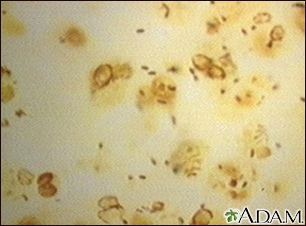Legionnaires disease
Legionella pneumonia; Pontiac fever; Legionellosis; Legionella pneumophila; Legionnaires' disease
Legionnaires disease is an infection of the lungs and airways. It is caused by Legionella bacteria.
Images

Causes
The bacteria that cause Legionnaires disease have been found in water delivery systems. They can survive in the warm, moist air conditioning systems of large buildings, including hospitals.
Most cases are caused by the bacteria Legionella pneumophila. The rest of the cases are caused by other Legionella species.
Spread of the bacteria from person to person has not been proven.
Most infections occur in middle-aged or older people. In rare cases, children can get the infection. When they do, the disease is less severe.
Risk factors include:
- Alcohol use
- Cigarette smoking
- Chronic illnesses, such as kidney failure or diabetes
- Long-term (chronic) lung disease, such as COPD
- Long-term use of a breathing machine (ventilator)
- Medicines that suppress the immune system, including chemotherapy and steroid drugs
- Older age
Symptoms
Symptoms tend to get worse during the first 4 to 6 days. They most often improve in another 4 to 5 days.
Symptoms may include:
- General discomfort, loss of energy, or ill feeling (malaise)
- Headache
- Fever, shaking chills
- Joint pain, muscle aches and stiffness
- Chest pain
- Cough that does not produce much sputum or mucus (dry cough)
- Coughing up blood (rare)
- Diarrhea, nausea, vomiting, and abdominal pain
- Shortness of breath
Exams and Tests
The health care provider will perform a physical exam. Abnormal sounds, called crackles, may be heard when listening to the chest with a stethoscope.
Tests that may be done include:
- Arterial blood gases
- Blood cultures or other tests to identify the bacteria
- Bronchoscopy to view the airways and diagnose lung disease
- Chest x-ray or CT scan
- Complete blood count (CBC), including white blood cell count
- Liver blood tests
- Tests and cultures on sputum to identify Legionella bacteria
- Urine tests to check for Legionella pneumophila bacteria
- Molecular tests with polymerase chain reaction (PCR)
Treatment
Antibiotics are used to fight the infection. Treatment is started as soon as Legionnaire disease is suspected, without waiting for results of any lab test.
Other treatments may include receiving:
- Fluids through a vein (IV)
- Oxygen, which is given through a mask or breathing machine
- Medicines that are breathed in to ease breathing
Outlook (Prognosis)
Legionnaires disease can be life threatening. The risk of dying is higher in people who:
- Have long-term (chronic) diseases or compromised immune systems
- Become infected while in the hospital
- Are older adults
When to Contact a Medical Professional
Contact your provider right away if you have any type of breathing problem and think you have symptoms of Legionnaires disease.
Related Information
RespiratoryCommunity-acquired pneumonia in adults
Acute kidney failure
Chronic obstructive pulmonary disease (COPD)
Pneumonia in adults - discharge
References
Edelstein PH, Roy CR. Legionnaires' disease and Pontiac fever. In: Bennett JE, Dolin R, Blaser MJ, eds. Mandell, Douglas, and Bennett's Principles and Practice of Infectious Diseases. 9th ed. Philadelphia, PA: Elsevier; 2020:chap 232.
Marrie TJ. Legionella infections. In: Goldman L, Schafer AI, eds. Goldman-Cecil Medicine. 26th ed. Philadelphia, PA: Elsevier; 2020:chap 298.
BACK TO TOPReview Date: 1/22/2023
Reviewed By: Denis Hadjiliadis, MD, MHS, Paul F. Harron, Jr. Professor of Medicine, Pulmonary, Allergy, and Critical Care, Perelman School of Medicine, University of Pennsylvania, Philadelphia, PA. Also reviewed by David C. Dugdale, MD, Medical Director, Brenda Conaway, Editorial Director, and the A.D.A.M. Editorial team. Editorial update 01/19/2024.

Health Content Provider
06/01/2025
|
A.D.A.M., Inc. is accredited by URAC, for Health Content Provider (www.urac.org). URAC's accreditation program is an independent audit to verify that A.D.A.M. follows rigorous standards of quality and accountability. A.D.A.M. is among the first to achieve this important distinction for online health information and services. Learn more about A.D.A.M.'s editorial policy, editorial process and privacy policy. A.D.A.M. is also a founding member of Hi-Ethics. This site complied with the HONcode standard for trustworthy health information from 1995 to 2022, after which HON (Health On the Net, a not-for-profit organization that promoted transparent and reliable health information online) was discontinued. |
The information provided herein should not be used during any medical emergency or for the diagnosis or treatment of any medical condition. A licensed medical professional should be consulted for diagnosis and treatment of any and all medical conditions. Links to other sites are provided for information only -- they do not constitute endorsements of those other sites. © 1997- 2025 A.D.A.M., a business unit of Ebix, Inc. Any duplication or distribution of the information contained herein is strictly prohibited.
